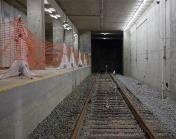Bacilius anthracis contamination cleanup
Partners: Washington Metropolitan Area Transit Authority (DC), Fort A.P. Hill Fire Department (VA), Lawrence Livermore National Laboratory (CA), Massachusetts Institute of Technology Lincoln Laboratories, Sandia National Laboratories (CA, NM), Virginia Commonwealth Department of Environmental Quality, Laboratory Response Network Laboratories (FL, MI, MN, NY, OH, VA), U.S. Department of Defense, U.S. Coast Guard
Challenge: Cleanup of a Bacillus anthracis contaminated subway
Resources: Full scale demonstration of technologies
Project Period: 2016-2018
"The work being done with the Underground Transportation Restoration Operational Technology Demonstration project has been critically important to helping Washington Metropolitan Area Transit Authority and other mass transit properties face the daunting preparedness challenges associated with an accidental or intentional release of a biological agent in the underground transportation environment. The project has helped inform our leadership in determining operational strategies that will lead to a more rapid return to service following such an event." – Homeland Security Investigations and Intelligence Bureau Metro Transit Police Department, CBRN Coordinator Brandon W. Graham
Following the 2001 Bacillus anthracis attacks, cleanup of the Hart Senate Office Building and Brentwood postal facility cost in excess of $1 billion, and it resulted in the Brentwood postal facility being closed for over two years. Since that time, EPA ORD has done a great deal of work to improve the nation’s ability to cleanup buildings contaminated with Bacillus anthracis or other biological agents. In recognition of the complexities that would be involved, and the number of cities that have underground rail systems, EPA along with the Department of Homeland Security (DHS), the Department of Defense and several national laboratories turned their attention to the cleanup of subway systems that could be contaminated with Bacillus anthracis.
The Underground Transportation Restoration (UTR) Operational Technology Demonstration (OTD) was conducted during September 2016 at Fort A.P. Hill’s Asymmetric Warfare Training Center to evaluate decontamination technologies that could be used in the event of an Bacillus anthracis incident in a subway system. The project used a non-pathogenic surrogate that behaves much like Bacillus anthracis spores in terms of how it is transported in the air, settles and how it can be killed. The project consisted of two rounds of background sampling, agent release, decontamination, sampling, waste removal and decontamination, and post-decontamination sampling. The technologies that were evaluated included a fogger that produced a fog from diluted bleach and a skid mounted sprayer that sprayed a liquid pH adjusted bleach solution. Both technologies were selected because they are off-the-shelf and could easily be purchased in an emergency.
A report was published in 2018 that thoroughly analyzed each step of the cleanup process (gathering of samples, cleanup methods, waste management) as well as cost associated with each. The results of this study concluded that there was no significant difference between the two cleanup methods. Utilizing approaches that reduce cost, such as composite sampling which decreases the need for labor and supplies, data management, sample shipment, and laboratory analysis, could make cleanup more manageable. The study noted that waste management is an integral piece of the cleanup process and should be determined both during pre-incident and response planning due to its impact on cost and logistics. This information was provided to DHS which has developed site-specific plans for San Francisco and New York as well as guidance that could be used in other cities.
Read the final report (link will open in a new tab or window) titled Underground Transport Restoration (UTR) Operational Technology Demonstration (OTD).
